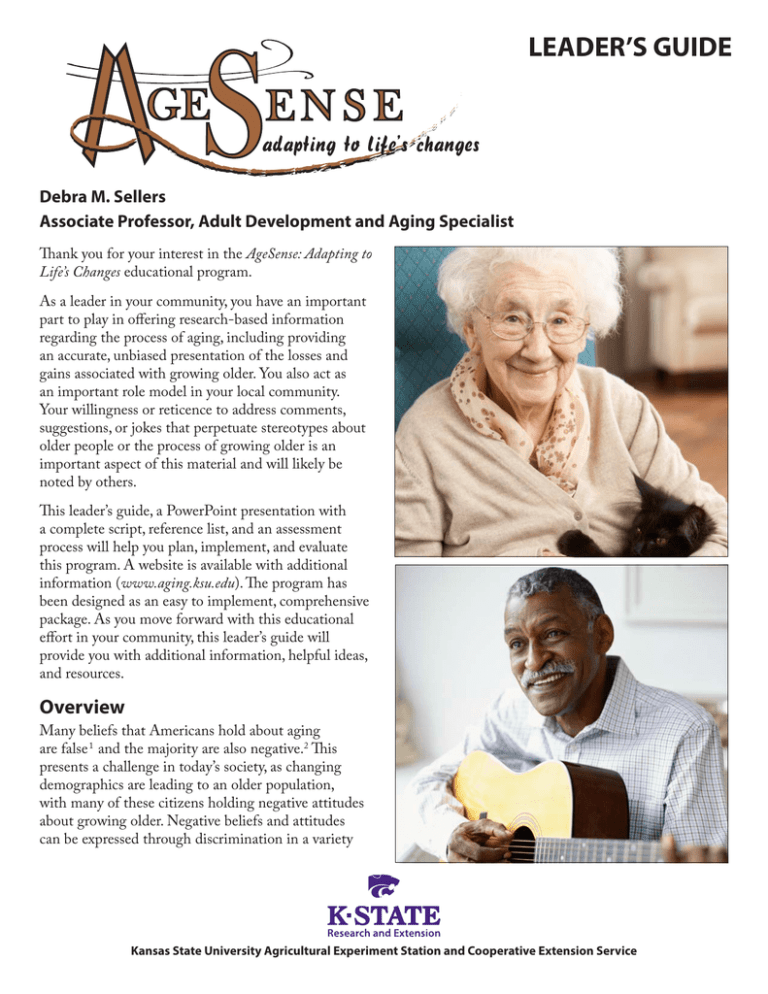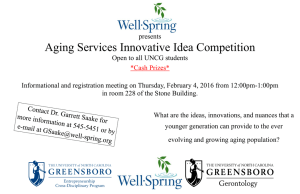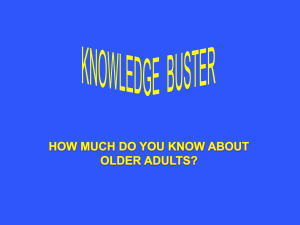
s
LEADER’S GUIDE
ge e ns e
adapting to life’s changes
Debra M. Sellers
Associate Professor, Adult Development and Aging Specialist
Thank you for your interest in the AgeSense: Adapting to
Life’s Changes educational program.
As a leader in your community, you have an important
part to play in offering research-based information
regarding the process of aging, including providing
an accurate, unbiased presentation of the losses and
gains associated with growing older. You also act as
an important role model in your local community.
Your willingness or reticence to address comments,
suggestions, or jokes that perpetuate stereotypes about
older people or the process of growing older is an
important aspect of this material and will likely be
noted by others.
This leader’s guide, a PowerPoint presentation with
a complete script, reference list, and an assessment
process will help you plan, implement, and evaluate
this program. A website is available with additional
information (www.aging.ksu.edu). The program has
been designed as an easy to implement, comprehensive
package. As you move forward with this educational
effort in your community, this leader’s guide will
provide you with additional information, helpful ideas,
and resources.
Overview
Many beliefs that Americans hold about aging
are false 1 and the majority are also negative.2 This
presents a challenge in today’s society, as changing
demographics are leading to an older population,
with many of these citizens holding negative attitudes
about growing older. Negative beliefs and attitudes
can be expressed through discrimination in a variety
Kansas State University Agricultural Experiment Station and Cooperative Extension Service
of channels, including health care, nursing homes,
emergency services, the workplace, and the media.3
“Ageism” is “more than images, words, actions, or
attitudes. It is deeply embedded in society in many
areas,” according to Robert Butler, a professor of
geriatrics at Mt. Sinai School of Medicine.4
•Speaker’s script
•Participant engagement activities
•Fact sheet (MF3079)
•Program assessments
PowerPoint Presentation
One way to reduce ageism is through education.5 People
who know more about the aging process are think
more positively about aging.6 People who have positive
self-perceptions of aging take part in additional healthrelated behaviors 7 and may live longer.8
The program is designed to be delivered in your
communities. The PowerPoint presentation provides
visual interest for the material presented, but, as a
leader, you may adapt the PowerPoint presentation,
create an alternative visual aid, or provide the lesson
without its use.
More Information and Resources
For additional information and research about aging,
the process of growing older, and attitudes and beliefs,
please see the reference list provided. For a list of
references for the fact sheet, as well as the PowerPoint,
program assessment, MyPlan form, and other
materials, visit www.aging.ksu.edu/p.aspx?tabid=203.
Speaker’s Script
The information in the speaker’s script covers all
the objectives and includes notations of when to use
the participant engagement activities, the program
assessments, and other important information.
Audience
Participant Engagement Activities
(PAE)
This program is designed for the general public.
Any adult with an interest in learning more about
older adults and the process of growing older may be
interested in attending.
There are four opportunities for you to directly involve
your audience members with the program content.
•Who is Old? (written comments) In this PAE,
participants are asked to anonymously write a
truthful answer to this question on notecards. You
will collect these and read a few of the answers.
Key Ideas and Objectives
Groucho Marx once remarked that anyone can get old
— all you have to do is live long enough. But growing
older is more than merely marking time. Individual
and societal beliefs and attitudes about growing older
fall onto a continuum of negative to positive views.
Research provides a balanced understanding of what
it means to age and also offers a way of thinking
about aging as another stage in life’s journey. Upon
completion of the session, participants will:
•What’s Your Aging IQ? (written quiz) Several
weeks before the presentation, order this
booklet (you may also download copies) from
the National Institute on Aging (see below for
ordering information). As you will not have time
to allow your audience to read and complete all
28 questions, have your audience choose a few at
random to answer. Alternatively, you can decide
before the program what questions you want to
have them complete. You may want to tailor your
choices for different audiences. Allow participants
to take the booklets home to complete the rest of
the questions.
•examine their own beliefs about aging;
•explore the dual ideas of loss and opportunity as
they relate to aging; and
•discover a model for understanding the aging
process.
•Discussion Question. Ask participants why
the majority of people do not want to consider
themselves “old.” Engage in a brief discussion
of this topic. It is important to respect people’s
opinions while addressing implicit stereotypes.
Format
The program is designed to be delivered in 60 to 75
minutes. The program consists of five main items:
•PowerPoint presentation found on the website (or
your adaptation/creation of another visual aid)
2
Getting Started
•Complete the “My Plan” Form. Pass out the “My
Plan” form to participants and ask them to commit
to one action that will positively influence their
personal aging process.
Before you implement this program, you will want to:
•Choose date(s).
•Choose an alternative date in case of weatherrelated problems or another event.
•Determine the registration process.
•Schedule a facility and room large enough to meet
your needs.
•Ensure the facility has tables, because participants
are asked to complete forms.
•Arrange for refreshments (if provided).
•Market the program.
•Review all the resources, including the speaker’s
script.
•Print copies of the fact sheet and “My Plan” form
for your participants.
•Order the booklet from the National Institute on
Aging.
•Decide if you will use the PowerPoint presentation
and ensure you have the equipment needed.
•Gather all needed supplies (notecards, pens, other
materials).
•Decide how you will incorporate the assessment
process and print copies of the form.
Fact Sheet
The fact sheet mirrors information provided in the
PowerPoint presentation. You may choose to give
the fact sheet to participants at the beginning of the
program to use as a guide as you present the content.
The fact sheet may also be used as a “take-home”
message for participants.
Program Assessments
It is important to understand and communicate the
impact of the program both in the short- and mediumterm. Please view the assessment process as an integral
component of the overall program. The assessment
process has been approved by the Institutional Review
Board of Kansas State University. The post-assessment
will gauge perceived changes in knowledge from
participants as a result of attending the program and
is voluntary and confidential. There is no way to trace
the answers back to individuals unless they voluntarily
leave their contact information.
There is an option of conducting follow-up telephone
interviews with participants in order to gather data
regarding the medium-term outcomes of the program.
A telephone interview protocol has been provided with
a script and questions to ask. Please enter all of your
data into the K-PICS system. This allows you to have
immediate feedback and data for your reporting needs.
Summary
Supplies Needed:
Information
AgeSense: Adapting to Life’s Changes is a research-based,
educational program designed for the general public.
The objectives include helping people understand their
own beliefs about aging and discover ways to adapt
to the aging process. Thank you for your interest in
providing this program in your local communities.
•Pens
•Notecards
•PowerPoint presentation (or your adaptation)
•Technical equipment to present the PowerPoint
(computer, LCD, screen, extension cord)
•Fact sheet (MF3079)
•What’s Your Aging IQ? booklet from the National
Institute on Aging. Free. Delivery of printed
materials will take 2 to 4 weeks. Order or download
(28 pages) from: www.nia.nih.gov/health/
publication/whats-your-aging-iq
•“My Plan” form
•Post-assessment form
•Telephone interview form (used approximately 90
days after program end)
Joan Kahl, jkahl@ksu.edu
Extension Associate, FCS
Family Studies and Human Services
343 Justin Hall
Kansas State University
Manhattan, KS 66506
Phone: 785-532-1905
www.aging.ksu.edu
3
References
Schaie, K.W., & Willis, S.L. (2002). Adult development and
aging (5th ed.). Upper Saddle River, NJ: Prentice-Hall.
1
Levy, B. (2003). “Mind matters: Cognitive and physical
effects of aging self-stereotypes.” Journal of Gerontology:
Psychological Sciences, 58B(4), 203-11.
2
International Longevity Center-USA, LTD. (2006). Ageism
in America. (Available from: Intergenerational Longevity
Center-USA, 60 East 86th Street, New York, New York,
10028)
3
Butler, R.N. (2005). “Ageism: Looking back over my
shoulder.” Generations, 29(3), 84-86.
4
Publications from Kansas State University are available at: www.ksre.ksu.edu
Publications are reviewed or revised annually by appropriate faculty to reflect
current research and practice. Date shown is that of publication or last revision.
Contents of this publication may be freely reproduced for educational purposes.
All other rights reserved. In each case, credit Debra Sellers, AgeSense: Adapting to
Life’s Changes, Leader’s Guide, Kansas State University, August 2013.
Palmore, E. (2005). “Three decades of research on ageism.”
Generations, 29(3), 87-90.
5
Palmore, E. (2005). “Facts on aging quiz.” In: E.B. Palmore,
L. Branch, & D.K. Harris (Eds.), Encyclopedia of ageism
(136-138). Binghamton, NY: Haworth Press.
6
Levy, B. & Myers, L. (2004). “Preventative health behaviors
influenced by self-perceptions of aging.” Preventative
Medicine, 39, 625-29.
7
Levy, B., Slade, M., Kunkel, S., & Kasl, S. (2002).
“Longevity increased by positive self perceptions of aging.”
Journal of Personality and Social Psychology, 83(2), 261-70.
8
Kansas State University Agricultural Experiment Station and Cooperative
Extension Service
K-State Research and Extension is an equal opportunity provider and employer.
Issued in furtherance of Cooperative Extension Work, Acts of May 8 and June
30, 1914, as amended. Kansas State University, County Extension Councils,
Extension Districts, and United States Department of Agriculture Cooperating,
John D. Floros, Director.
MF3080
August 2013


